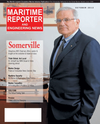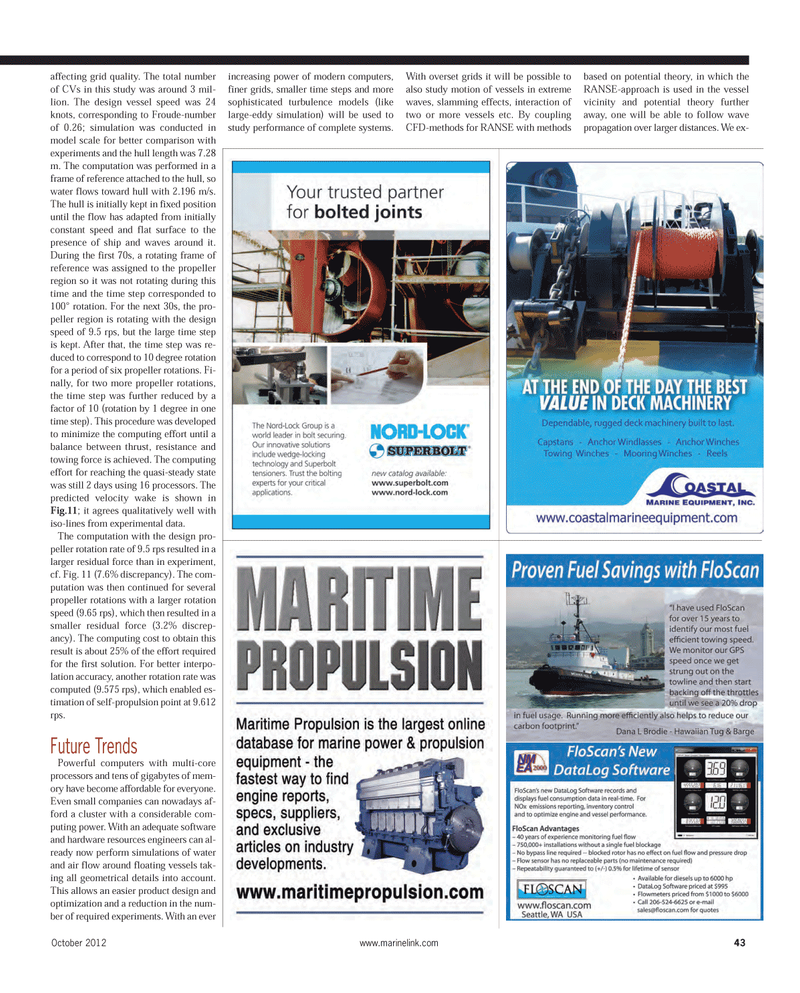
Page 43: of Maritime Reporter Magazine (October 2012)
Marine Design & Construction
Read this page in Pdf, Flash or Html5 edition of October 2012 Maritime Reporter Magazine
October 2012www.marinelink.com 43affecting grid quality. The total number of CVs in this study was around 3 mil- lion. The design vessel speed was 24 knots, corresponding to Froude-numberof 0.26; simulation was conducted in model scale for better comparison withexperiments and the hull length was 7.28 m. The computation was performed in a frame of reference attached to the hull, sowater flows toward hull with 2.196 m/s. The hull is initially kept in fixed position until the flow has adapted from initially constant speed and flat surface to the presence of ship and waves around it. During the first 70s, a rotating frame of reference was assigned to the propeller region so it was not rotating during this time and the time step corresponded to100° rotation. For the next 30s, the pro- peller region is rotating with the design speed of 9.5 rps, but the large time step is kept. After that, the time step was re- duced to correspond to 10 degree rotation for a period of six propeller rotations. Fi-nally, for two more propeller rotations, the time step was further reduced by a factor of 10 (rotation by 1 degree in one time step). This procedure was developed to minimize the computing effort until a balance between thrust, resistance andtowing force is achieved. The computing effort for reaching the quasi-steady state was still 2 days using 16 processors. The predicted velocity wake is shown in Fig.11 ; it agrees qualitatively well with iso-lines from experimental data. The computation with the design pro-peller rotation rate of 9.5 rps resulted in alarger residual force than in experiment, cf. Fig. 11 (7.6% discrepancy). The com- putation was then continued for several propeller rotations with a larger rotation speed (9.65 rps), which then resulted in asmaller residual force (3.2% discrep-ancy). The computing cost to obtain this result is about 25% of the effort required for the first solution. For better interpo- lation accuracy, another rotation rate was computed (9.575 rps), which enabled es-timation of self-propulsion point at 9.612rps. Future Trends Powerful computers with multi-core processors and tens of gigabytes of mem- ory have become affordable for everyone. Even small companies can nowadays af- ford a cluster with a considerable com-puting power. With an adequate software and hardware resources engineers can al- ready now perform simulations of water and air flow around floating vessels tak- ing all geometrical details into account.This allows an easier product design and optimization and a reduction in the num-ber of required experiments. With an ever increasing power of modern computers, finer grids, smaller time steps and more sophisticated turbulence models (like large-eddy simulation) will be used to study performance of complete systems.With overset grids it will be possible to also study motion of vessels in extreme waves, slamming effects, interaction of two or more vessels etc. By coupling CFD-methods for RANSE with methodsbased on potential theory, in which the RANSE-approach is used in the vessel vicinity and potential theory furtheraway, one will be able to follow wave propagation over larger distances. We ex- MR#10 (42-49):MR Template 10/4/2012 11:09 AM Page 43

 42
42

 44
44
